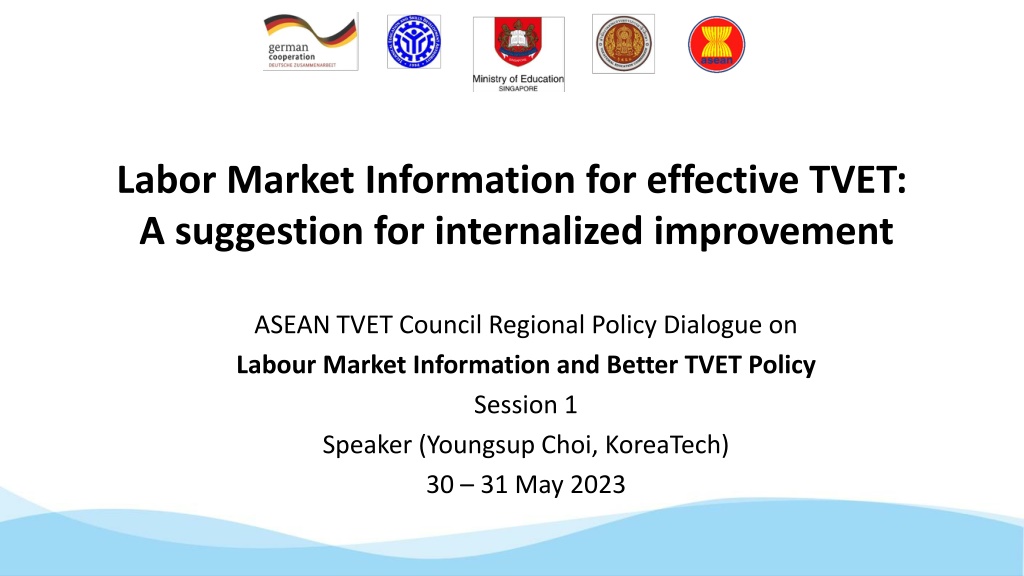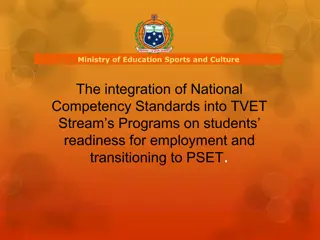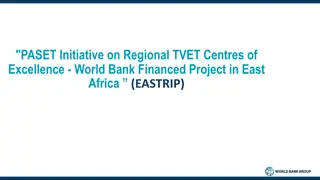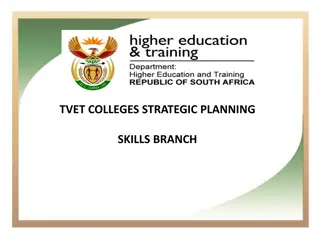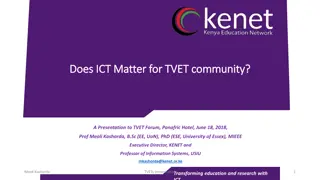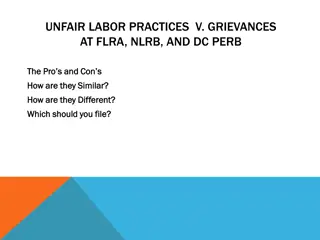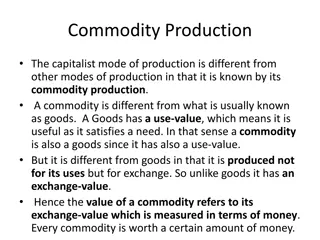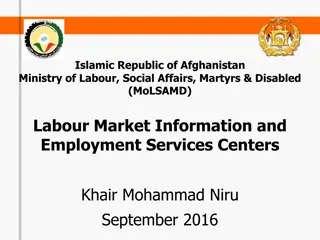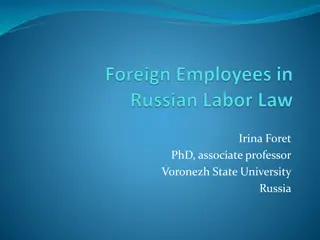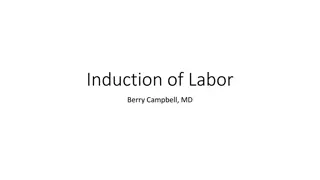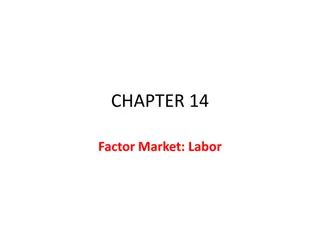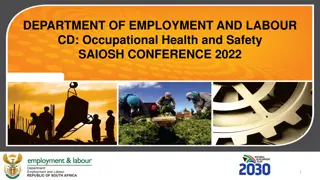Enhancing TVET Through Improved Labor Market Information
Explore the importance of better Labor Market Information (LMI) for Technical and Vocational Education and Training (TVET) policies, shifting from supply to demand orientation. Understand the classification of LMI and its sources, emphasizing the need for both quantitative and qualitative data. Delve into the current LMI situation in ASEAN Member States, highlighting areas for improvement in skills demand information.
Download Presentation

Please find below an Image/Link to download the presentation.
The content on the website is provided AS IS for your information and personal use only. It may not be sold, licensed, or shared on other websites without obtaining consent from the author. Download presentation by click this link. If you encounter any issues during the download, it is possible that the publisher has removed the file from their server.
E N D
Presentation Transcript
Labor Market Information for effective TVET: A suggestion for internalized improvement ASEAN TVET Council Regional Policy Dialogue on Labour Market Information and Better TVET Policy Session 1 Speaker (Youngsup Choi, KoreaTech) 30 31 May 2023
1. Better LMI for better TVET: Why more importance? Changes of perspective on skills policy: From Supply to Demand Blinded expansion of learning? More relavance to the economic and socail demand From Supply-oriented to Demand-oriented/Outcome-based approach Not only for current, but also for future needs Increased turbulence and uncertainty: Be prepared for the future Basis for effective policy design and policy evaluation A lighthouse by itself never guaranttee safe journey during a storm However, without a lighthouse in dark sea, no possibilty of correct navigation to a port
2. Classification of LMI and their sources LMI for TVET: Comprehsensive and Detailed Areas Demand side Supply side Characteristics Quantitative Employment data Vacancy data Laborturnover data Education statistics Graduate statistics Tracersurvey Qualitative New skill needs Employer satisfaction Curriculum analysis
Quantitative info: Statistical data Mostly from sampled surveys on households and employers Robust statistics on various aspects of the labor market However, limited information about concrete skills issues Need for more detailed information Qualitative info: Employers engagement Employers opinion regarded as highly essential High risk of subjectivism and necessity of intensive consultation process
3. Current situation of LMI in ASEAM MS Table 1 LMI on Skills Demand 3.1. LMI on Skills Demand Statistics on Countries Training led by firms Skills Future labor demand Required skills in the future Relatively well developed LMI for the overall employment Employment Establishment Job vacancy requirement Thailand Limited info on job matching Vietnam Myanmar Limited info on skills requirement Brunei Cambodia Indonesia Malaysia The Philippines Singapore Lao DPR Source: Regional report on ASEAN-ROK TEAM project, 2022. 5
3.2. LMI on Skills Supply Table 2 LMI on Skills Supply Statistics on LMI for skills supply is also relatively well established Countries Learning to work transition Quality of education and training Labor Supply Education and training Job seekers Thailand Well developed Info on official E&T sector Vietnam Myanmar Little info on adults training Brunei Cambodia Limited info on Learning-to- Work Indonesia Malaysia The Philippines Singapore Lao DPR 6
Table 3 Employer engagement 3.3. Employer engagement The Existence of The Degree of Influence of Countries Meetings Law or Regulation Meeting to TVET Employers to TVET Relatively active employer engagements at the national and sectoral level N R S N R S N R S N R S Thailand Vietnam At the regional level, however, room for improvement as in some, no engagement of employers Myanmar Brunei x x x Cambodia x x NA NA Indonesia x x x x NA NA Malaysia x x NA NA The Philippines Singapore x x NA NA Lao PDR 7
Suggested recommendations for LMI improvement Review results clearly showed the diverse situation of LMIS in AMSs: Some with sophisticated future labor market projections . Policy Implications and Recommendations Some lacking very basic labor market statistics Necessity and urgency of common improvement of the LIMS in every AMSs and, Pivotal role of ASEAN through ASEAN-wide activities along with national activities 8
4. Challenges of improving TVET through improved LMI 4.1. Na ve claim and hesitated judgement A na ve claim of skills needs identification: To adat E&T programs to the needs of the labor market, just conduct a large scale survey about employers needs Continued complaints: Why so poor performance of TVET, in spite of so much money inputed to such large scale employer survey? To address such situation, need to understand the inherent complexity of identification of skills needs and reflection of them into E&T progams 9
4.2. Four key steps for identifying skills needs 1. Produt market changes More on electric vehicles, less on internal combustion engine 2. Labor demand changes by occupation level More on software experts, less on traditional mechanical engineers 3. Competence requirements changes More knowledge on software even for mechanical engineers 4.Education and training changes More software courses in curricular for mechanical engineers Considerable degree of uncertainty and confusion at each step 10
4.3. Typical disruptions at each stage 1. Produt market changes: Exaggerated expectations Delayed reality By 2020, Fully Autonomous (Level 5) Vehicle? Only Level 3 Driver Assist! 2. Labor demand changes: Statistics = Statistical error (Error Future of Craftworkers: Accurate, but what use? Data scientists: Desperate, but really reliable? Fundamental conflicts b/w Reliability vs. Usability Size ) 3. Competence requirements changes Individual employers with own requirements Difficulty of distilling into industry-wide requirement 4. Education and training changes E&T providers tend to set them within their capacity: Sometimes drifted way from employer s needs 10/6/2024 11
4.4. Realistic understanding about stakeholders involved Employers: Highly expertized on their own business but not on skills issues Skills: Interested in, but not their top priority (=PROFIT!!) Concerned on their business: Short-sighted and selfish Difficulty of distilling concrete needs into society wide agenda Who are Employers ?: Business owner? Executives? HR managers? Learning providers: Experts on skills issues but encaptured on their own interests Leveraging vast expertize on skills issues, able to modify the policies towards their interests Various excuses for the poor performance of education and training Performance of learning = f(quality of teachers + quality of students) & labor market situation Governments: Under pressure of showing concrete results No one denies the importance of better LMI; but very few with actual commitment Supports to LMI for fundamental improvement of TVET = long term bebefits + beyond their term Inclined to launch projects more likely to achieve short term results 10/6/2024 12
5. How make better LMI for better TVET? One-big-change? NO! Just Step-by-Step improvement! Most essential basis: no matter how much resources required Quantitative: At least quaterly Labor Force Survey, annual establishment survey, tracer survey for targeted group Qualitative: Low(school/institution) level dialogue with employers, assisted by institutional incentives Far more importance to daily dialogue & Be patient! Continued efforts for improvement: Sisyphus' labor, but inevitable Understanding skills needs: No possibility of accurate estimation at once Only rough/initial guess Gadual improvement And so on Simultaneous development of Production AND Circulation of LMI! 10/6/2024 13
Not just a matter of size of financial inputs; But, more critically, a matter of human/organizational capacity Importance of securing internal and organizational capacity Organizational memory vs. Personal memory Individuals come and go: Organization will stay continued improvement Internal expertise vs. External expertise Mobilize external expertize but not completely rely on! contextualized improvement One critical element of Korea s progress: Well supported national policy institutes! 10/6/2024 14
Thank you very much! youngsup.choi.yc@gmail.com 10/6/2024 15
